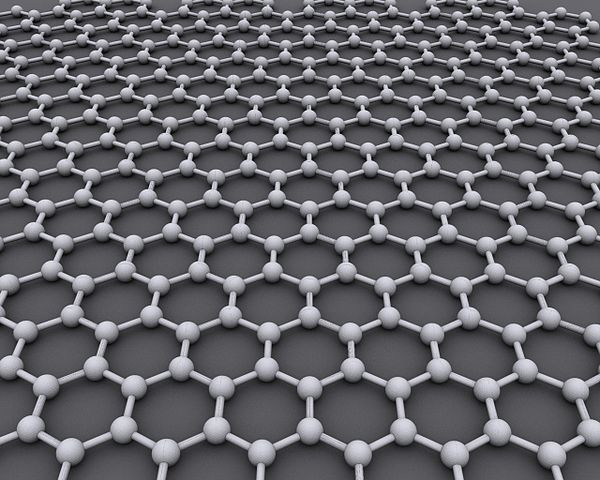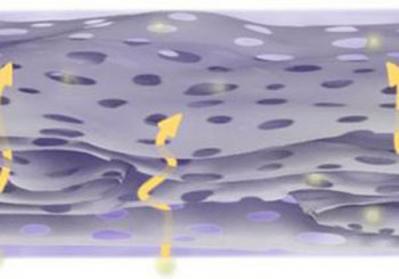G R A P H E N E
Have you heard of Sir Andre Geim?
You should have heard of him. In 2004 he, together with his research colleague Sir Konstantin Novoselov, made what is likely to prove the most momentous achievement of the 21st century. They isolated the 2 dimensional material graphene, identified many of its extraordinary properties and subsequently described other 2 dimensional materials. Their work is of such importance that both were awarded the 2010 Nobel Prize in Physics, knighted by the Queen and by the King of the Netherlands and over the past decade have been showered with numerous honours and awards.
Properties
Graphene does not occur naturally. It is produced from pure graphite by stripping away layers of the material until left with a single layer – a feat initially achieved using adhesive tape. It comprises atoms of carbon linked together in a hexagonal pattern forming a sheet one atom (0.35 nm) thick. 1 gram of graphene is sufficient to cover an area of 2,630 square metres and one square metre weighs 0.77 milligrams.

Fig. 1 Atomic structure of graphene. Each atom in the hexagon lattice is only 0.14 nm apart, preventing passage of any molecule. Source: Wikipedia.
It is a very stable, chemically inert material which has x200 the strength of steel yet is malleable - its surface area can be stretched by 20%. It can be folded and crumpled, vastly increasing its surface area within the confines of a very small space. Graphene is an excellent thermal conductor and in its pure form is 97.7% transparent.
Inability to produce graphene on an industrial scale initially limited development of technology into an ever-growing range of applications. These problems have now been overcome, even to the extent that a graphene ink has been developed enabling the printing of graphene sheets and other items containing graphene. Sir Andre rightly describes Graphene as the foundation of far reaching disruptive technology. It has the potential to replace and bring about the rapid demise of fossil fuels as an energy source, possibly within a decade and this alone justifies its description as a ‘wonder material’.
Solar Panels
The best commercially available photovoltaic panels are silicon based and have an efficiency of ~21%. The best efficiency in converting photons in sunlight to an electron flow was 25.6% achieved with crystalline silicon photovoltaic cells, a record held until December 2014 when multi-junction cells achieved efficiency of 46%, the present record. Subsequent research shows that graphene absorbs photons from a wider spectrum of sunlight and that each photon absorbed produces multiple electrons indicating the possibility of achieving an efficiency of 60% without the need for solar concentration.
It is likely that photovoltaic cells with an efficiency x2 that of cells presently in use could be widely available by 2020. It is probable that development of graphene solar cells may also be commercialized by then. They will revolutionize solar panel cost-efficiency and significantly reduce the cost of generating electricity from sunlight, adding to their competitive advantage over fossil fuelled power stations.
Solar panel power stations would then have telling advantages over fossil fuelled generators because: 1) their capital cost is far less, 2) operating costs are far less since their fuel, sunlight, is free, 3) maintenance costs are low because solar panels are durable and easily replaced and 4) they are not limited to being located near a fossil fuel source but can be located anywhere and supply either a national or local grid. However, unlike fossil fuelled power stations, they would still not be able to provide power 24/7 without durable and cost-efficient energy storage, probably in excess of 24 hours supply.
Electricity Storage
Graphene has already been used to vastly improve the recharge time (reportedly 15 minutes) and increased the capacity (by as much as x10) of Lithium batteries, supercapacitors and recently developed supercapacitor-battery hybrids. Testing of holey graphene oxide shows ultra-high capacitances of 283 Farads/gram and 234 Farads/cm3. By combining graphene with Manganese Dioxide (MnO2) capacitance of 1,100 Farads/ cm3 have been achieved.  Fig. 2 Holey Graphene is a 3D material that has tiny holes in it. Close-up view of framework film; arrows highlight ion-transport pathway short-cut. Source: NanoWerk and Graphene Info
Fig. 2 Holey Graphene is a 3D material that has tiny holes in it. Close-up view of framework film; arrows highlight ion-transport pathway short-cut. Source: NanoWerk and Graphene Info
UCLA researchers have developed a new graphene based material, holey graphene, enabling production of a capacitor that has unparalleled energy density, x10 that of currently available supercapacitors. Holey graphene features superior electrical conductivity, exceptional mechanical flexibility and unique hierarchical porosity, making it ideal for use as a cathode in electro-chemical capacitors and batteries. These characteristics may give some credence to claims that a 10,000 Farad ultra-supercapacitor, smaller than a paperback book, has been produced – a major development if true and one with revolutionary potential for electric propulsion.
Less clear is the period required for commercialization of these achievements. The commercial imperative is to take the market from Tesla’s PowerWall (now selling) and Porsches 500km/charge sports car (coming), with graphene based products. With superior durability, storage capacity and the best recharge time for any supercapacitor-battery hybrid it seems possible that graphene competition in the world market could begin in 2018, possibly sooner. It could be well established, offering vastly improved, efficient and very competitively priced energy storage products by 2025.
Over the following decade, this is likely to have two far reaching effects: a) It will be possible to store large amounts of electricity more efficiently generated from solar energy by more efficient solar panels and: b) the range, recharge time and reliability of electric vehicles (EV’s) of all descriptions will be vastly improved and much cheaper.
Effect on Power Stations
By using enhanced solar panels, power stations will be able to generate and store electricity in sufficient quantity to ensure continuous 24/7 supply to a local or national grid and do so more cheaply and cleanly than fossil fuels. Fossil fuelled power stations are likely to be rapidly replaced and production of their fuel will decline with similar rapidity, leaving both as stranded assets of low or no commercial value.
Existing fossil fuelled power stations in Australia are now largely fully amortised. Given the advances described above, it is unlikely that any will be replaced, other than by solar power stations. New fossil fuelled power stations are most unlikely to be built.
Effect on Oil Refining
The Oil Industry will only flourish as long as constraints on use of EV’s remain in place. They are vehicle price (at present often double for EV’s), refueling time (over 40 hours from standard mains) and kilometres per charge (usually under 200 km. only Tesla offers 450 km). The price for EV’s is so high because of the cost of its batteries but availability of relatively inexpensive graphene batteries and supercapacitors immediately overcome these constraints.
By 2020 it is likely that graphene batteries and supercapacitors will store sufficient electricity to enable an EV to accelerate rapidly, travel at least 500 km on a single charge and recharge in a time dictated largely by available current supply. As soon as these vehicles become available to the public, uptake will be rapid, market driven and by 2025 EV’s could be the vehicle of choice. It is possible that by 2030 most passenger vehicles propelled by an internal combustion engine will have been consigned to history.
It is reasonable to expect that from 2020-2030 demand for crude oil and oil based motor fuels will decline and be accompanied by contraction in the number of refineries engaged in fuel production.
Conclusion
As long as profit is to be made from production and use of fossil fuels they will be exploited. Even if some governments attempt to curb emissions, others will not. Even if global agreement on limiting emissions is achieved, implementation is unlikely to be.
The only way to curb production of fossil fuels and ultimately end their use is to replace them with an affordable, reliable alternative. That alternative is electricity generated from an emissions-free source, possibly from Generation IV nuclear reactors, certainly and more likely from solar energy because it is free of radio-active waste and its fuel is free.
To-date, the constraint on renewable energy remains a cost-effective way of storing electricity in sufficient quantity to provide 24/7 supply or, in the case of transport, to ensure readily available, rapid recharge after a vehicle has travelled a minimum of 500 km/charge. As outlined above, graphene technology has the potential to remove these constraints.
Commercialisation of graphene technology has begun and is continuing to make advances which are likely to see the electric motor (95% efficient) replace the internal combustion engine (20% efficient) and fossil fuelled power stations in the 2020’s. These disruptions could be largely completed by 2030 followed by clean electrification of the most demanding of industries and equipment.
The fundamental reason why graphene technology will succeed is displacing fossil fuels, where other technologies have failed, is because of the extraordinary properties of graphene and its composites. These make it comparatively efficient in the generation and storage of electricity and, for many other applications, it is a cheaper and more versatile material.
Help us do science! we’ve teamed up with researcher Paige Brown Jarreau to create a survey of Skeptical Science readers. By participating, you’ll be helping me improve SkS and contributing to SCIENCE on blog readership. You will also get FREE science art from Paige's Photography for participating, as well as a chance to win a t-shirt and other perks! It should only take 10-15 minutes to complete. You can find the survey here: http://bit.ly/mysciblogreaders. For completing the survey, readers will be entered into a drawing for a $50.00 Amazon gift card, as well as for other prizes (i.e. t-shirts).
Posted by Riduna on Tuesday, 10 November, 2015



